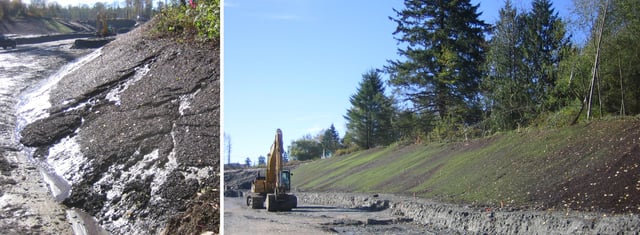By implementing the use of vegetative and compost-based solutions to prevent erosion on slopes, the volume of stormwater runoff is reduced. Washington State DOT has successfully implemented erosion control solutions throughout the state. Their Roadside Manual is an excellent resource, clearly explaining the process of erosion and offers tools for site assessment and Best Management Practices. Following are some excepts from Section 710:
What is erosion?
Erosion is a natural process that can be greatly accelerated by human activities, especially those that change or remove vegetation or that disturb the soil. In addition to human activities, fire and animal activities can also accelerate erosion. Soil is composed of mineral and organic matter and takes thousands of years to develop. The U.S. is losing topsoil seventeen times faster than it develops. All construction activities have the potential to cause soil erosion. Therefore, erosion prevention and sediment control are components of any project that disturbs vegetation or soil horizons. Erosion prevention will reduce both the need for costly sediment controls and the risk of environmental damage.

Process of Erosion (Water)
- Raindrop – The impact of raindrops on bare soil displaces soil particles. Over the duration of a storm, significant volumes of sediment are made available to be transported.
- Sheet – As rain accumulates a non-concentrated, uniform layer of runoff is formed. This sheet flow transports detached soil from raindrop impacts, as well as plucks off additional soil particles caused by the shear stress of the runoff.
- Rill – When sheet flows converge, increased volumes and velocities of water are concentrated. Small, intermittent watercourses with steep sides, known as rills, are formed. They are usually only a few inches deep.
- Gully – When rills converge, and/or impervious surfaces focus runoff in a single location, a large channel, known as a gully, is formed. Volumes and velocities of water, along with shear stress are increasing dramatically.
- Stream Bank – Bank erosion of existing streams/channels is caused by increased peak flows.
Factors Affecting Severity of Erosion
- Gravity
- Soil Type and Texture
- Precipitation & Climate
- Storm intensity, storm duration,
- Vegetation
- Surface Area
- Slope Length & Gradient
- Surface Texture
Vegetation is the single most important element in the prevention and control of erosion from wind and water.
.jpg?width=320&name=2015%2009%20%20(1).jpg)
Maintaining or reestablishing vegetation is fundamental in preventing erosion. Eroding sites require stabilization through the use of measures such as:
- vegetation
- check dams to slow water
- impervious soil tackifiers
- soil particle binders to bind soil particles together
- erosion prevention blankets to reduce the force of water splash on soils
- In more extreme cases, walls to decrease slope angle or barriers to block wind may be needed.
Site Analysis
An assessment of the factors affecting erodibility, whether before, during, or after construction, can provide critical information about erosion potential. Erosion and sediment control efforts are most effective when addressed during the planning or design phase.
Address the following elements in a comprehensive appraisal of the site:
- Topography.
- Water source, direction of flow, and local depressions.
- Prevailing wind direction.
- Average and extreme rainfall patterns.
- Vegetation present on site and at an appropriate reference site.
- Sensitive areas such as adjacent wetlands or streams.
- General soil type(s).
- Angle and length of slope.
- Type of erosion feature, when present: rills, gullies, bank undercutting, alluvial fans, etc..
- Pre-development stormwater runoff flow.
- Adjacent land use and associated impervious surfaces and runoff
Erosion Prevention & Control BMPs
Erosion control BMPs are used to prevent and/or minimize soil loss. Erosion control is more effective at preventing turbid runoff than sediment control. Project sites require erosion control when vegetation is removed, when the soil is disturbed, or when water flow has the potential to cause erosion. All erosion control BMPs require regular maintenance.
Principles for vegetative erosion control include, but are not limited to:
- Minimize the disturbance to desirable vegetation (The less disturbed, the less to stabilize).
- Limit or eliminate the following activities in the area:
- Soil compaction.
- Mechanical damage to roots and above-ground vegetation.
- Alterations to desired hydrological patterns.
- Deposition or addition of chemicals detrimental to plants or soil environment.
- Clearing. (If grubbing is not necessary, cut off tops and leave roots.)
The following list gives an overview of recommended erosion prevention & control practices.
Recommended Erosion Prevention & Control Practices |
| Design the Temporary Erosion Control Plan (TESC) for the project. |
| Avoid extensive grading and earthwork in erosion prone areas. |
| Preserve desirable vegetation whenever reasonable. |
| Consider clearing the site in small increments whenever vegetation must be removed. Limit the duration of exposure to erosional processes. |
| Install erosion prevention BMPs prior to any grading activity. |
| Install hydraulic conveyance system to handle increased runoff. |
| Keep runoff velocities low. |
| Divert runoff from steep slopes and bare areas by constructing interceptor drains and berms. |
| Divert “clean” water away from disturbed areas. |
| Protect cleared areas with mulches and temporary, fast growing herbaceous covers. |
| Soils that create exceptionally highly turbid runoff, such as clay and silt, should receive further protection. |
| Inspect and maintain BMPs. |
| Understand that erosion control plans and SSPs must be modified to fit the site conditions at any point in time. |
Sediment Control BMPs
.jpg?width=320&name=2007%2007%20Kicking%20Horse%20Hwy%20Project%20(17).jpg)
Conventional sediment control BMPs are capable of removing a certain size soil particle, but in most cases it is not enough to bring the runoff in compliance with state water quality standards. Detention time and volume is critical in sediment control. Sand and gravel takes only seconds to trap, but silt and clay can take hours to weeks to settle. Providing such detention time is not always possible. Thus, preventing erosion in the first place makes sediment control more effective.



